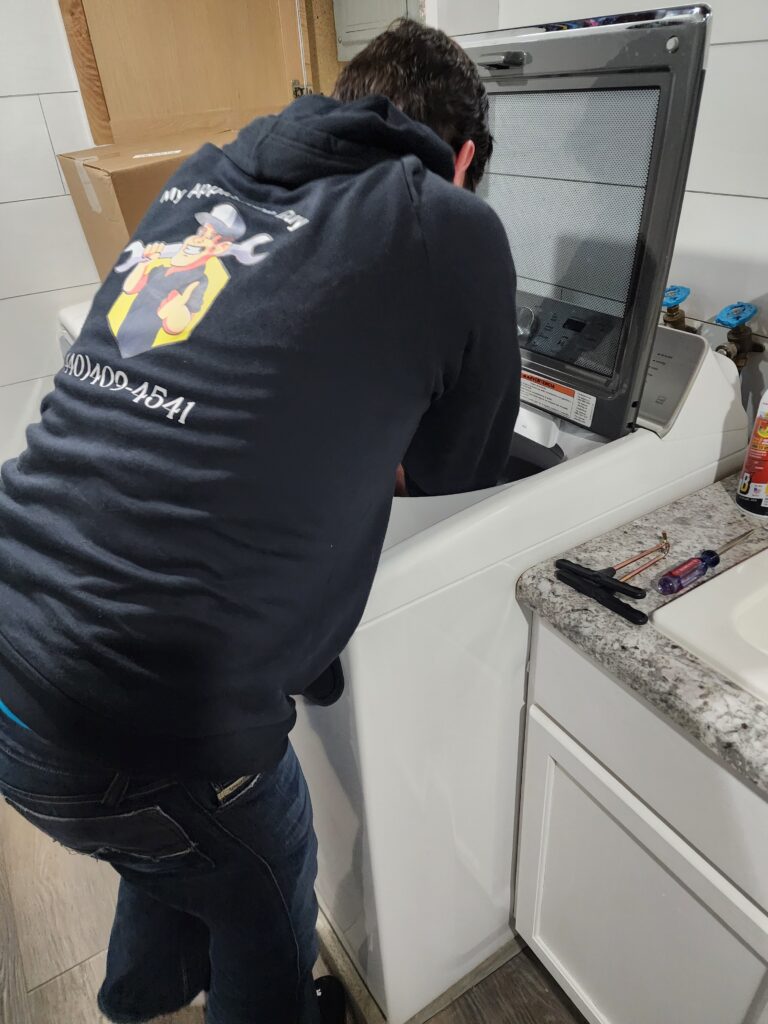At My Appliance Guy, we understand the critical role that reliable appliances play in making everyday tasks easier. When a washing machine malfunctions, it can quickly disrupt your household routine. Recently, we had the opportunity to perform a Maytag washing machine repair for a customer in Beachwood, Ohio. This job highlights our commitment to providing timely and efficient service, ensuring that our customers can continue with their daily lives without the hassle of a broken appliance.
In this job listing of ours, we will walk you through the specifics of the repair job, from the initial customer call to the final resolution. We’ll also touch on how My Appliance Guy approaches appliance repairs, ensuring quality service every step of the way.

The Initial Call: Maytag Washing Machine Not Draining
Our customer in Beachwood, Ohio contacted us after experiencing issues with their Maytag washing machine. The customer explained that the washer was not draining properly after completing a cycle, leaving clothes soaked and the drum full of water. This problem made it impossible to finish laundry loads, as the machine couldn’t perform the final steps of its wash cycle.
Understanding how inconvenient this was, we quickly scheduled an appointment to send one of our expert technicians to assess the issue. We know that a malfunctioning washing machine can be a major disruption, so our goal was to resolve the issue as soon as possible to restore the appliance’s functionality.
Technician Arrival at the Beachwood Residence
Our technician arrived at the customer’s home in Beachwood, Ohio, and was immediately briefed by the homeowner about the issue. The homeowner pointed out that the washing machine had been having trouble draining for the past few days. Initially, they attempted to troubleshoot the issue by turning the washer off and restarting it, but the problem persisted. This led them to seek professional help from My Appliance Guy.
The technician conducted an initial inspection of the machine and asked the homeowner to demonstrate the problem. After running a brief cycle and observing the machine, the technician confirmed that the washing machine was indeed not draining. The water was not being expelled from the drum after the washing cycle was completed, leaving clothes wet and in need of manual wringing.
Diagnostic Process: Identifying the Problem
Once the issue was identified, the technician began a thorough diagnostic process to pinpoint the cause of the malfunction. There are several potential reasons why a washing machine may fail to drain, and the technician wanted to ensure that the repair would address the root of the problem. Based on the symptoms, the technician suspected a few common culprits, including a clogged drainage hose, a faulty pump, or an issue with the washer’s control board.
1. Checking the Drain Hose for Clogs
The first step in diagnosing the issue was to inspect the drain hose. A clogged or kinked drain hose can prevent water from flowing out of the washing machine, leading to drainage problems. The technician carefully disconnected the drain hose from the back of the washer and inspected it for blockages. After a visual inspection, the technician used a special tool to check for any clogs within the hose. Fortunately, the hose appeared to be clear, so the technician ruled out this potential issue.
2. Inspecting the Drain Pump
The next step in the diagnostic process was to check the drain pump. The pump is responsible for expelling the water from the drum during the drain cycle. If the pump is clogged or damaged, it can prevent the washer from draining properly.
The technician removed the pump cover and inspected the pump for debris, damage, or wear. Upon inspection, the technician discovered that the drain pump was indeed clogged with lint and small debris, which had accumulated over time. This blockage was preventing the pump from operating efficiently and expelling water from the drum. The technician carefully cleaned the pump to remove the debris and tested it to ensure that it was functioning properly.
3. Examining the Control Board
After addressing the pump, the technician turned his attention to the control board. The control board is responsible for managing various functions of the washing machine, including the drainage cycle. A malfunctioning control board can sometimes cause issues with the washer’s ability to complete its cycles, including the drain function.
The technician performed a diagnostic check on the control board, ensuring that it was sending the proper signals to the pump to activate the drainage process. After confirming that the control board was functioning correctly, the technician determined that the issue was not related to the board, and that the primary cause of the problem was the clogged drain pump.
The Repair Process: Fixing the Drain Pump
Once the technician identified the clogged drain pump as the source of the issue, they proceeded with the repair. The first step was to clean out all the debris that had accumulated in the pump, ensuring that it was free from blockages. The technician used a specialized cleaning solution and tools to remove the lint and debris, which had been preventing the pump from draining water properly.
Once the pump was cleared of all debris, the technician reassembled the washer and tested it to ensure that the water was now draining correctly. After running a few test cycles, the technician confirmed that the washing machine was functioning as it should, with water draining freely from the drum.
Testing the Washing Machine
After the repair was complete, the technician ran several test cycles to ensure that the Maytag washing machine was operating at peak performance. The technician tested both the drain cycle and other essential functions of the washer, including washing and spinning, to confirm that the machine was working properly across all stages of the cycle.
During the test, the technician observed that the washer was draining properly, with no signs of water remaining in the drum after each cycle. Additionally, the spinning function was operating smoothly, ensuring that the clothes would be properly spun and not excessively wet when removed from the drum.
Customer Education: Tips for Preventing Future Issues
Once the repair was successfully completed, the technician took a moment to educate the homeowner on how to prevent similar issues from occurring in the future. While some problems, like clogged drain pumps, are inevitable over time, there are several maintenance tips that can help keep the washing machine in good working condition.
1. Regularly Clean the Drain Pump Filter
The technician advised the homeowner to periodically clean the drain pump filter to prevent lint and debris from building up. This simple maintenance task can go a long way in ensuring that the pump operates efficiently and doesn’t become clogged.
2. Check the Drain Hose for Blockages
While the drain hose was not the issue in this case, the technician recommended regularly checking the hose for any signs of kinks, blockages, or leaks. Ensuring that the hose remains clear will help prevent drainage issues in the future.
3. Use the Right Detergent
The technician also reminded the homeowner to use the appropriate detergent for their washer and to avoid overloading the machine with laundry. Using too much detergent can create excessive suds, which can contribute to drainage problems and other malfunctions.

Conclusion: A Job Well Done
The Maytag washing machine repair in Beachwood, Ohio, was a success, thanks to the skill and expertise of the technician from My Appliance Guy. By addressing the clogged drain pump and cleaning the debris that was causing the issue, we were able to restore the washing machine to full functionality. The homeowner was pleased with the prompt and efficient service, and we were happy to help them get back to their normal routine.
At My Appliance Guy, we take pride in offering high-quality appliance repair services throughout the Beachwood area. Whether you’re dealing with a faulty washing machine, refrigerator, or any other household appliance, our team is ready to assist. Contact us today for all your appliance repair needs, and let us help you keep your home running smoothly.
